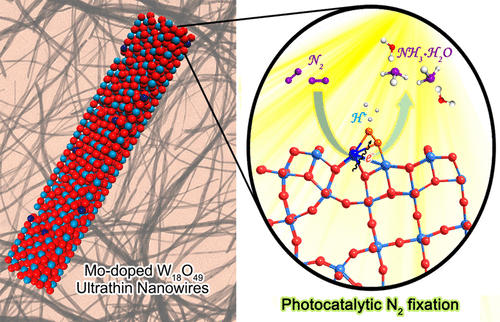当前位置:
X-MOL 学术
›
J. Am. Chem. Soc.
›
论文详情
Our official English website, www.x-mol.net, welcomes your
feedback! (Note: you will need to create a separate account there.)
Refining Defect States in W18O49 by Mo Doping: A Strategy for Tuning N2 Activation towards Solar-Driven Nitrogen Fixation
Journal of the American Chemical Society ( IF 14.4 ) Pub Date : 2018-07-05 , DOI: 10.1021/jacs.8b02076 Ning Zhang 1 , Abdul Jalil 1 , Daoxiong Wu 1 , Shuangming Chen 1 , Yifei Liu 1 , Chao Gao 1 , Wei Ye 1 , Zeming Qi 1 , Huanxin Ju 1 , Chengming Wang 1 , Xiaojun Wu 1 , Li Song 1 , Junfa Zhu 1 , Yujie Xiong 1
Journal of the American Chemical Society ( IF 14.4 ) Pub Date : 2018-07-05 , DOI: 10.1021/jacs.8b02076 Ning Zhang 1 , Abdul Jalil 1 , Daoxiong Wu 1 , Shuangming Chen 1 , Yifei Liu 1 , Chao Gao 1 , Wei Ye 1 , Zeming Qi 1 , Huanxin Ju 1 , Chengming Wang 1 , Xiaojun Wu 1 , Li Song 1 , Junfa Zhu 1 , Yujie Xiong 1
Affiliation

|
Photocatalysis may provide an intriguing approach to nitrogen fixation, which relies on the transfer of photoexcited electrons to the ultrastable N≡N bond. Upon N2 chemisorption at active sites (e.g., surface defects), the N2 molecules have yet to receive energetic electrons toward efficient activation and dissociation, often forming a bottleneck. Herein, we report that the bottleneck can be well tackled by refining the defect states in photocatalysts via doping. As a proof of concept, W18O49 ultrathin nanowires are employed as a model material for subtle Mo doping, in which the coordinatively unsaturated (CUS) metal atoms with oxygen defects serve as the sites for N2 chemisorption and electron transfer. The doped low-valence Mo species play multiple roles in facilitating N2 activation and dissociation by refining the defect states of W18O49: (1) polarizing the chemisorbed N2 molecules and facilitating the electron transfer from CUS sites to N2 adsorbates, which enables the N≡N bond to be more feasible for dissociation through proton coupling; (2) elevating defect-band center toward the Fermi level, which preserves the energy of photoexcited electrons for N2 reduction. As a result, the 1 mol % Mo-doped W18O49 sample achieves an ammonia production rate of 195.5 μmol gcat-1 h-1, 7-fold higher than that of pristine W18O49. In pure water, the catalyst demonstrates an apparent quantum efficiency of 0.33% at 400 nm and a solar-to-ammonia efficiency of 0.028% under simulated AM 1.5 G light irradiation. This work provides fresh insights into the design of photocatalyst lattice for N2 fixation and reaffirms the versatility of subtle electronic structure modulation in tuning catalytic activity.
中文翻译:

通过 Mo 掺杂精炼 W18O49 中的缺陷状态:调整 N2 活化以实现太阳能驱动固氮的策略
光催化可能为固氮提供了一种有趣的方法,它依赖于光激发电子转移到超稳定的 N≡N 键。在活性位点(例如,表面缺陷)处发生 N2 化学吸附后,N2 分子尚未接收高能电子以实现有效的激活和解离,这通常会形成瓶颈。在这里,我们报告说,通过掺杂改进光催化剂中的缺陷态可以很好地解决瓶颈问题。作为概念证明,W18O49 超薄纳米线被用作精细 Mo 掺杂的模型材料,其中具有氧缺陷的配位不饱和 (CUS) 金属原子作为 N2 化学吸附和电子转移的位点。掺杂的低价钼物质通过细化 W18O49 的缺陷态在促进 N2 活化和解离方面发挥多种作用:(1) 使化学吸附的 N2 分子极化,促进电子从 CUS 位点转移到 N2 吸附物,使 N≡N 键更容易通过质子耦合解离;(2) 将缺陷带中心提升到费米能级,这保留了用于 N2 还原的光激发电子的能量。结果,1 mol % Mo 掺杂的 W18O49 样品实现了 195.5 μmol gcat-1 h-1 的氨产率,是原始 W18O49 的 7 倍。在纯水中,该催化剂在模拟 AM 1.5 G 光照射下在 400 nm 处表现出 0.33% 的表观量子效率和 0.028% 的太阳能转化氨效率。这项工作为 N2 固定光催化剂晶格的设计提供了新的见解,并重申了微妙的电子结构调节在调节催化活性方面的多功能性。
更新日期:2018-07-05
中文翻译:

通过 Mo 掺杂精炼 W18O49 中的缺陷状态:调整 N2 活化以实现太阳能驱动固氮的策略
光催化可能为固氮提供了一种有趣的方法,它依赖于光激发电子转移到超稳定的 N≡N 键。在活性位点(例如,表面缺陷)处发生 N2 化学吸附后,N2 分子尚未接收高能电子以实现有效的激活和解离,这通常会形成瓶颈。在这里,我们报告说,通过掺杂改进光催化剂中的缺陷态可以很好地解决瓶颈问题。作为概念证明,W18O49 超薄纳米线被用作精细 Mo 掺杂的模型材料,其中具有氧缺陷的配位不饱和 (CUS) 金属原子作为 N2 化学吸附和电子转移的位点。掺杂的低价钼物质通过细化 W18O49 的缺陷态在促进 N2 活化和解离方面发挥多种作用:(1) 使化学吸附的 N2 分子极化,促进电子从 CUS 位点转移到 N2 吸附物,使 N≡N 键更容易通过质子耦合解离;(2) 将缺陷带中心提升到费米能级,这保留了用于 N2 还原的光激发电子的能量。结果,1 mol % Mo 掺杂的 W18O49 样品实现了 195.5 μmol gcat-1 h-1 的氨产率,是原始 W18O49 的 7 倍。在纯水中,该催化剂在模拟 AM 1.5 G 光照射下在 400 nm 处表现出 0.33% 的表观量子效率和 0.028% 的太阳能转化氨效率。这项工作为 N2 固定光催化剂晶格的设计提供了新的见解,并重申了微妙的电子结构调节在调节催化活性方面的多功能性。









































 京公网安备 11010802027423号
京公网安备 11010802027423号